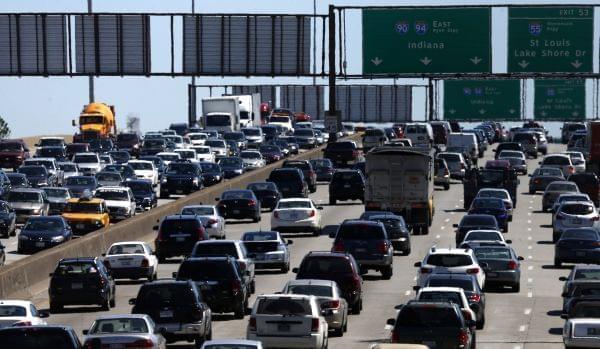Where Illinois Emissions Come From; News Podcasts For The Summer; Midwest Earthquakes

Charles Rex Arbogast/AP
Cars and trucks recently surpassed coal as the number one source of emissions in Illinois. We’ll talk about what led to this shift and what policies Illinois should put in place. Plus, one of the largest earthquakes recorded in the US happened in the Midwest in 1811. So how likely are earthquakes in the Midwest today? And, you might be on the hunt for news podcasts to listen to during your summer travels. We’ve got some recommendations for you during a summer podcast series we’re doing all week.
Last fall, the UN issued a report which said that the world needs to reach net zero in carbon emissions by 2050. If we don’t, hundreds of millions more people will be at risk from the effects of climate change.
The key to avoiding that warming is cutting emissions around the world. But the source of carbon emissions is a bit different in every community.
Here in Illinois, the number one source of emissions has been coal. For decades, actually. Now though, there’s a new leader — exhaust from cars and trucks.
Brett Chase reported on this for the Better Government Association. Gabriel Filippelli is a professor and director with the Center for Urban Health at IUPUI. Brian Urbaszewski is the director of environmental health policy at the Respiratory Health Association.
"We still commute quite a bit - we're taking Uber and Lyft instead of public transportation. And we're also ordering quite a bit of online deliveries. You're seeing more and more trucks deliver Amazon and other goods."
— The 21st (@21stShow) June 17, 2019
Read @brettchase's @BetterGov piece: https://t.co/UyOqk5R9Bf
Also--
As you look for summer podcast recommendations, we wanted to suggest two podcasts on today’s show that work to make heavy and complex topics a little more digestible for listeners.
One of those podcasts is “An Arm and a Leg,” the cleverly named show about the price of health care from Dan Weissman. You may know him from his reporting on shows like Marketplace, Planet Money or Chicago’s NPR station, WBEZ. Dan joined us to talk about a few of the surprising, and frustrating, health care cost stories featured on his podcast — but he also hopes that you come away feeling both empowered and entertained by these stories.
There are lots of great podcasts to help you understand what’s going on — not just in Washington but around the world. One of them is from the news website Vox — and it’s called Today Explained.
Sean Rameswaram is the host of Today Explained.
"All of us have the experience of getting a bill and saying 'why is this so much,'" says @danweissmann.
— The 21st (@21stShow) June 17, 2019
He says he hopes people will take away some tips for navigating the healthcare system while also realizing they're not alone in dealing with this.
"We just wanted to set the tone for the episode. I don't think it's easy to sell an episode about zoning... so I wanted to get you jazzed about it," says @rameswaram about the song.
— The 21st (@21stShow) June 17, 2019
"And then we have a serious episode... the news doesn't have to sound super flat and boring." https://t.co/AyY2yu987F
Plus--
Residents near Cleveland were probably surprised last Monday when a 4.2 magnitude earthquake rattled Northeast Ohio. According to the US Geological Survey, an earthquake of that magnitude is noticeable but doesn’t cause much damage at all.
It’s a good reminder, though, that earthquakes do happen in the Midwest. In fact, geologists say large, damaging earthquakes have occurred in the Midwest in the past and are expected again.
In 1811 and 1812, there were a series of earthquakes in the middle of the country known as the New Madrid earthquakes, some of the largest in American history. They were so strong that for a short time they changed the direction the Mississippi River flowed.
Conevery Valencius is a history professor at Boston College, who wrote a book about the New Madrid quakes. Tim Larson is a Senior Geophysicist with the Illinois State Geological Survey.
Tim Larson from @ILGeoSurvey says today, there are still DAILY earthquakes in New Madrid fault zone, although most you can't feel.
— The 21st (@21stShow) June 17, 2019
Are people prepared? "That's a loaded question." People in Southern IL are more so than Northern, but many don't remember when they do happen. pic.twitter.com/ngVPKiaByH
